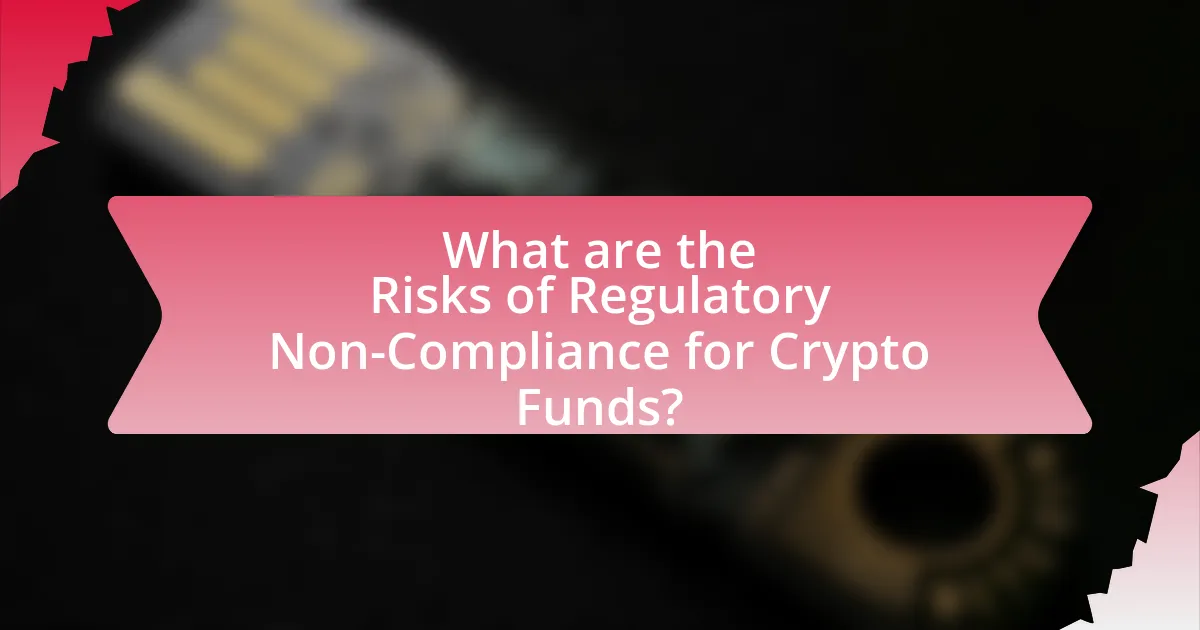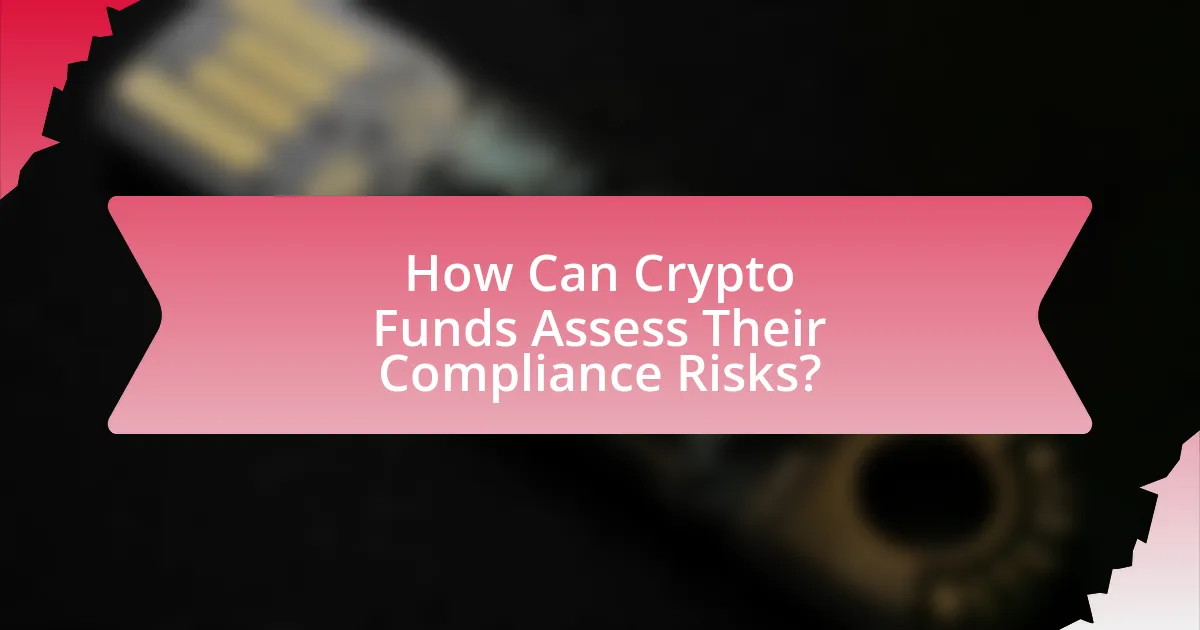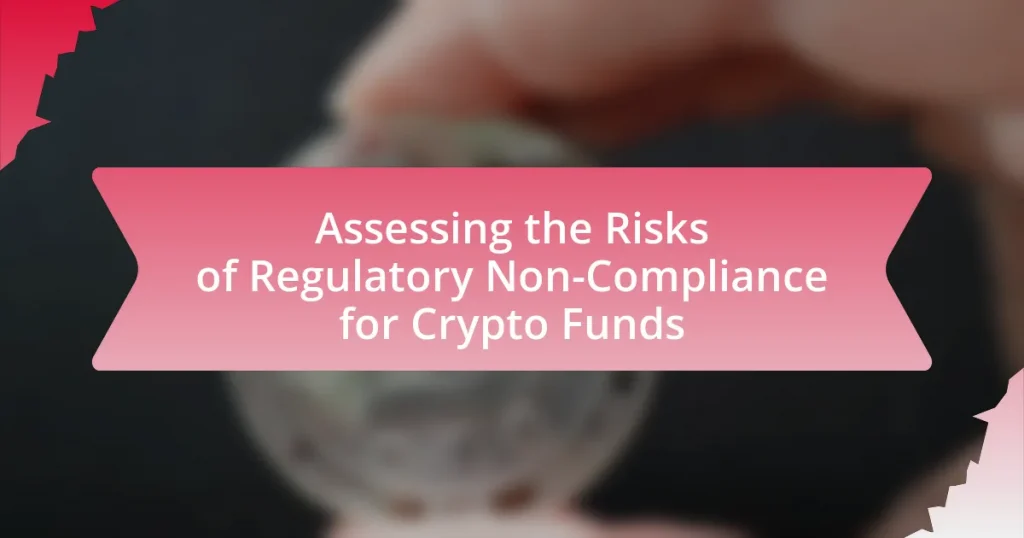The article focuses on the risks associated with regulatory non-compliance for crypto funds, highlighting potential legal penalties, financial losses, and reputational damage. It emphasizes the importance of regulatory compliance in enhancing investor confidence and mitigating legal risks, detailing various regulations such as anti-money laundering (AML) and know your customer (KYC) requirements. The article also discusses the complexities of navigating regulatory landscapes, the role of technology in compliance efforts, and best practices for crypto funds to develop robust compliance programs. Additionally, it outlines the significance of ongoing training, legal counsel, and regular audits in maintaining compliance and fostering a culture of accountability within organizations.

What are the Risks of Regulatory Non-Compliance for Crypto Funds?
The risks of regulatory non-compliance for crypto funds include legal penalties, financial losses, and reputational damage. Legal penalties can manifest as fines or sanctions imposed by regulatory bodies, which can reach millions of dollars, as seen in cases like the SEC’s actions against various crypto firms. Financial losses may arise from the inability to operate legally, leading to loss of investor confidence and withdrawal of funds. Reputational damage can severely impact a crypto fund’s ability to attract new investors, as trust is crucial in the financial sector. For instance, the collapse of companies like FTX highlighted how non-compliance can lead to a rapid decline in market position and investor trust.
Why is Regulatory Compliance Important for Crypto Funds?
Regulatory compliance is crucial for crypto funds because it mitigates legal risks and enhances investor confidence. By adhering to regulations, crypto funds can avoid penalties, legal actions, and reputational damage that arise from non-compliance. For instance, the Financial Action Task Force (FATF) guidelines require crypto entities to implement anti-money laundering (AML) measures, which help prevent illicit activities and foster a safer investment environment. Compliance also facilitates access to banking services and partnerships, as financial institutions are more likely to engage with compliant entities. Thus, regulatory compliance not only protects crypto funds from legal repercussions but also promotes trust and stability in the cryptocurrency market.
What are the potential legal consequences of non-compliance?
The potential legal consequences of non-compliance for crypto funds include substantial fines, legal sanctions, and potential criminal charges. Regulatory bodies, such as the Securities and Exchange Commission (SEC) in the United States, can impose penalties that may reach millions of dollars, depending on the severity of the violation. For instance, in 2021, the SEC fined a crypto company $1.5 million for failing to register its securities offerings. Additionally, non-compliance can lead to restrictions on business operations, loss of licenses, and reputational damage, which can further impact financial stability and investor trust.
How does non-compliance affect investor trust and market reputation?
Non-compliance significantly undermines investor trust and damages market reputation. When a crypto fund fails to adhere to regulatory standards, it raises concerns about transparency, accountability, and the overall integrity of the investment. For instance, the collapse of the cryptocurrency exchange Mt. Gox in 2014, which was linked to regulatory non-compliance, resulted in the loss of approximately $450 million in customer funds, leading to a severe decline in investor confidence across the market. This incident exemplifies how non-compliance can lead to a loss of credibility, prompting investors to withdraw their capital and seek safer alternatives, thereby negatively impacting the market’s reputation as a whole.
What Types of Regulations Do Crypto Funds Need to Comply With?
Crypto funds must comply with various regulations, including anti-money laundering (AML) laws, know your customer (KYC) requirements, and securities regulations. AML regulations require crypto funds to implement measures to prevent money laundering activities, while KYC mandates that funds verify the identities of their clients to prevent fraud and illicit activities. Additionally, if a crypto fund offers investment products that qualify as securities, it must adhere to the regulations set forth by the Securities and Exchange Commission (SEC) or equivalent regulatory bodies in their jurisdiction. Compliance with these regulations is crucial to mitigate legal risks and ensure operational legitimacy in the financial market.
What are the key regulatory frameworks governing crypto funds?
The key regulatory frameworks governing crypto funds include the Securities Act of 1933, the Investment Company Act of 1940, and the Financial Action Task Force (FATF) guidelines. The Securities Act of 1933 requires that any offering of securities, including those involving cryptocurrencies, must be registered with the SEC unless an exemption applies. The Investment Company Act of 1940 regulates investment companies, which can include crypto funds, ensuring they meet specific disclosure and operational standards. Additionally, the FATF guidelines provide an international framework for anti-money laundering (AML) and combating the financing of terrorism (CFT) measures that crypto funds must adhere to, promoting transparency and accountability in the crypto space. These frameworks collectively establish the legal landscape that crypto funds must navigate to ensure compliance and mitigate regulatory risks.
How do international regulations differ from local regulations?
International regulations differ from local regulations primarily in their scope and enforcement mechanisms. International regulations are designed to create a standardized framework that applies across multiple countries, often addressing global issues such as trade, finance, and environmental protection. For example, the Financial Action Task Force (FATF) sets international standards for combating money laundering and terrorist financing, which member countries are encouraged to implement. In contrast, local regulations are specific to individual jurisdictions and can vary significantly in terms of requirements, penalties, and enforcement practices. For instance, local regulations governing cryptocurrency may differ widely between countries, with some nations imposing strict licensing requirements while others adopt a more lenient approach. This divergence can lead to challenges for crypto funds operating in multiple jurisdictions, as they must navigate a complex landscape of varying compliance obligations.
What are the Common Challenges in Achieving Compliance?
Common challenges in achieving compliance for crypto funds include rapidly changing regulations, lack of standardized practices, and the complexity of technology integration. Rapidly changing regulations create uncertainty, making it difficult for crypto funds to stay compliant. The lack of standardized practices across jurisdictions leads to inconsistent compliance efforts, as different regions may have varying requirements. Additionally, the complexity of integrating compliance measures with existing technology systems poses significant hurdles, as many funds struggle to implement effective monitoring and reporting mechanisms. These challenges are compounded by the evolving nature of the cryptocurrency market, which can outpace regulatory frameworks.
What are the complexities of navigating regulatory landscapes?
Navigating regulatory landscapes is complex due to the variability of laws across jurisdictions, the rapid evolution of regulations, and the need for compliance with multiple regulatory bodies. Different countries have distinct legal frameworks that govern financial activities, particularly in the crypto sector, leading to challenges in ensuring compliance. For instance, the Financial Action Task Force (FATF) has issued guidelines that vary in implementation across member countries, creating inconsistencies. Additionally, the fast-paced nature of technological advancements in cryptocurrency often outstrips existing regulations, resulting in uncertainty and potential non-compliance risks for crypto funds. This complexity is further compounded by the necessity for ongoing monitoring and adaptation to new regulations, which can require significant resources and expertise.
How do technological advancements impact compliance efforts?
Technological advancements significantly enhance compliance efforts by automating processes, improving data accuracy, and enabling real-time monitoring. Automation reduces human error and increases efficiency, allowing organizations to manage compliance tasks more effectively. For instance, the implementation of artificial intelligence in compliance systems can analyze vast amounts of data quickly, identifying potential regulatory risks and ensuring adherence to laws. According to a report by Deloitte, 60% of organizations using advanced technologies for compliance reported improved accuracy in their compliance processes. This demonstrates that technology not only streamlines compliance but also strengthens the overall regulatory framework, particularly in complex sectors like crypto funds.

How Can Crypto Funds Assess Their Compliance Risks?
Crypto funds can assess their compliance risks by conducting thorough risk assessments that include evaluating regulatory frameworks, implementing robust internal controls, and engaging in regular audits. These assessments involve identifying applicable regulations, such as Anti-Money Laundering (AML) and Know Your Customer (KYC) requirements, and analyzing the fund’s operations against these standards. Regular audits and compliance checks help to ensure adherence to regulations and identify potential gaps in compliance. Additionally, utilizing compliance technology solutions can enhance monitoring and reporting capabilities, thereby reducing the risk of regulatory breaches.
What Tools and Strategies Can Be Used for Risk Assessment?
Risk assessment for regulatory non-compliance in crypto funds can be effectively conducted using tools such as risk matrices, scenario analysis, and compliance checklists. Risk matrices allow organizations to visualize and prioritize risks based on their likelihood and impact, facilitating informed decision-making. Scenario analysis helps in understanding potential future events and their implications, enabling proactive risk management. Compliance checklists ensure that all regulatory requirements are systematically reviewed and adhered to, reducing the likelihood of non-compliance. These tools are supported by frameworks like ISO 31000, which emphasizes a structured approach to risk management, and the use of software solutions that automate compliance monitoring and reporting, enhancing efficiency and accuracy in risk assessment.
How can risk assessment frameworks be applied to crypto funds?
Risk assessment frameworks can be applied to crypto funds by systematically identifying, analyzing, and mitigating risks associated with regulatory non-compliance. These frameworks enable crypto funds to evaluate their operational processes, compliance with anti-money laundering (AML) and know your customer (KYC) regulations, and exposure to market volatility. For instance, the Financial Action Task Force (FATF) guidelines provide a structured approach for assessing risks related to money laundering and terrorist financing in the crypto space. By implementing these frameworks, crypto funds can enhance their compliance measures, thereby reducing the likelihood of regulatory penalties and fostering investor confidence.
What role does technology play in compliance risk assessment?
Technology plays a crucial role in compliance risk assessment by automating data collection, analysis, and reporting processes. This automation enhances the efficiency and accuracy of identifying potential compliance risks, particularly in complex regulatory environments like those faced by crypto funds. For instance, advanced analytics and machine learning algorithms can analyze vast amounts of transaction data in real-time, flagging anomalies that may indicate non-compliance. According to a report by Deloitte, organizations that leverage technology for compliance risk management can reduce compliance costs by up to 30% while improving risk detection capabilities.
What Indicators Signal Potential Non-Compliance Risks?
Indicators that signal potential non-compliance risks for crypto funds include irregular transaction patterns, lack of transparency in fund operations, and failure to adhere to Know Your Customer (KYC) and Anti-Money Laundering (AML) regulations. Irregular transaction patterns, such as sudden spikes in trading volume or transactions that do not align with the fund’s stated investment strategy, can indicate potential illicit activities. Lack of transparency, including insufficient disclosure of fund management practices or unclear fee structures, raises red flags for regulators. Additionally, non-compliance with KYC and AML regulations, which are critical for preventing fraud and money laundering, can lead to significant legal repercussions. According to a 2021 report by Chainalysis, over $8.6 billion was laundered through cryptocurrencies, highlighting the importance of compliance in mitigating risks.
What are the warning signs of regulatory non-compliance?
Warning signs of regulatory non-compliance include inconsistent reporting, lack of transparency, and failure to adhere to established guidelines. Inconsistent reporting may manifest as discrepancies in financial statements or failure to disclose required information, which can indicate potential issues with compliance. Lack of transparency often surfaces when organizations do not provide clear information about their operations or financial practices, raising red flags for regulators. Additionally, failure to adhere to established guidelines, such as not following anti-money laundering (AML) or know your customer (KYC) regulations, can lead to significant legal repercussions. These signs are critical for identifying potential non-compliance risks in the context of crypto funds, where regulatory scrutiny is increasing.
How can crypto funds monitor their compliance status effectively?
Crypto funds can monitor their compliance status effectively by implementing robust compliance management systems that integrate real-time transaction monitoring, regulatory reporting, and risk assessment tools. These systems enable funds to track adherence to anti-money laundering (AML) and know your customer (KYC) regulations, which are critical for maintaining compliance in the rapidly evolving crypto landscape. For instance, utilizing blockchain analytics tools allows funds to analyze transaction patterns and identify suspicious activities, thereby ensuring compliance with regulatory requirements. Additionally, regular audits and compliance training for staff further reinforce adherence to regulations, as evidenced by the increasing number of regulatory fines imposed on non-compliant entities, highlighting the importance of proactive compliance monitoring.

What Best Practices Can Crypto Funds Implement to Mitigate Risks?
Crypto funds can implement several best practices to mitigate risks, including establishing robust compliance frameworks, conducting regular audits, and employing advanced cybersecurity measures. A strong compliance framework ensures adherence to regulatory requirements, which is crucial given the evolving nature of cryptocurrency regulations. Regular audits help identify potential vulnerabilities and ensure that operational practices align with compliance standards. Additionally, advanced cybersecurity measures, such as multi-signature wallets and cold storage solutions, protect assets from theft and hacking incidents, which have historically plagued the crypto industry. These practices collectively enhance the resilience of crypto funds against regulatory non-compliance and operational risks.
How Can Crypto Funds Develop a Robust Compliance Program?
Crypto funds can develop a robust compliance program by implementing a comprehensive framework that includes risk assessment, regulatory awareness, and ongoing monitoring. This framework should begin with identifying and assessing the specific regulatory risks associated with cryptocurrency transactions, such as anti-money laundering (AML) and know your customer (KYC) requirements.
To ensure compliance, crypto funds must stay updated on evolving regulations, which can vary significantly by jurisdiction. For instance, the Financial Action Task Force (FATF) provides guidelines that many countries adopt, emphasizing the need for crypto businesses to adhere to AML standards.
Additionally, establishing internal controls and procedures, including employee training and regular audits, is essential for maintaining compliance. According to a report by the International Monetary Fund (IMF), effective compliance programs can significantly reduce the risk of regulatory penalties and enhance the fund’s reputation in the market.
By integrating these elements, crypto funds can create a robust compliance program that not only meets regulatory requirements but also fosters trust among investors and stakeholders.
What are the essential components of an effective compliance program?
An effective compliance program consists of several essential components: a clear compliance framework, risk assessment procedures, employee training, monitoring and auditing mechanisms, and a reporting system. The compliance framework establishes the policies and procedures that guide the organization in adhering to regulations. Risk assessment procedures identify potential compliance risks specific to the organization, particularly in the context of crypto funds, where regulatory landscapes are rapidly evolving. Employee training ensures that all staff members understand compliance requirements and their roles in maintaining them. Monitoring and auditing mechanisms regularly evaluate the effectiveness of compliance efforts, while a reporting system allows for the identification and escalation of compliance issues. These components collectively ensure that organizations can proactively manage regulatory risks and maintain adherence to legal standards.
How can ongoing training and education improve compliance efforts?
Ongoing training and education enhance compliance efforts by ensuring that employees are well-informed about current regulations and best practices. Regular training sessions keep staff updated on changes in laws and compliance requirements, which is crucial in the rapidly evolving landscape of crypto funds. For instance, a study by the Association of Certified Financial Crime Specialists found that organizations with continuous training programs experienced a 30% reduction in compliance violations. This reduction is attributed to improved employee awareness and understanding of compliance obligations, leading to more effective adherence to regulatory standards.
What Role Does Legal Counsel Play in Ensuring Compliance?
Legal counsel plays a critical role in ensuring compliance by providing expert guidance on regulatory requirements and helping organizations navigate complex legal landscapes. They assess the legal implications of business operations, draft compliance policies, and conduct training to ensure that employees understand their obligations. Furthermore, legal counsel monitors changes in regulations and advises on necessary adjustments to maintain compliance, thereby mitigating risks associated with regulatory non-compliance. For instance, in the context of crypto funds, legal counsel helps interpret laws related to securities, anti-money laundering, and consumer protection, ensuring that the fund operates within legal boundaries and avoids penalties.
How can legal advisors assist in navigating regulatory challenges?
Legal advisors assist in navigating regulatory challenges by providing expert guidance on compliance with laws and regulations specific to the crypto industry. They analyze existing regulations, interpret legal requirements, and develop strategies to ensure that crypto funds adhere to applicable laws, thereby minimizing the risk of non-compliance. For instance, legal advisors can help crypto funds understand the implications of the Financial Action Task Force (FATF) guidelines and the European Union’s Anti-Money Laundering (AML) directives, which are critical for maintaining operational legitimacy. By offering tailored legal advice and risk assessments, legal advisors enable crypto funds to operate within the legal framework, thereby reducing potential penalties and enhancing investor confidence.
What should crypto funds look for when selecting legal counsel?
Crypto funds should prioritize legal counsel with expertise in cryptocurrency regulations and compliance. This expertise is crucial due to the rapidly evolving legal landscape surrounding digital assets, which requires a deep understanding of both local and international laws. Legal counsel should also have a proven track record of advising similar funds, demonstrating their capability to navigate complex regulatory environments effectively. Additionally, familiarity with the specific operational model of the crypto fund, whether it involves trading, investment, or token issuance, is essential for tailored legal advice. The increasing scrutiny from regulatory bodies, as evidenced by the heightened enforcement actions in recent years, underscores the importance of selecting legal counsel that can proactively address compliance risks and provide strategic guidance.
What Practical Steps Can Crypto Funds Take to Stay Compliant?
Crypto funds can stay compliant by implementing robust anti-money laundering (AML) and know your customer (KYC) procedures. These measures involve verifying the identities of clients, monitoring transactions for suspicious activity, and maintaining detailed records to ensure transparency. According to the Financial Action Task Force (FATF), adherence to these guidelines is essential for mitigating risks associated with regulatory non-compliance, as failure to comply can result in significant fines and legal repercussions. Additionally, crypto funds should regularly update their compliance policies to align with evolving regulations, conduct employee training on compliance issues, and engage with legal experts to navigate the complex regulatory landscape effectively.
How can regular audits enhance compliance efforts?
Regular audits enhance compliance efforts by systematically identifying and addressing gaps in adherence to regulatory standards. These audits provide a structured review of processes, ensuring that crypto funds operate within legal frameworks and mitigate risks associated with non-compliance. For instance, a study by the Financial Action Task Force (FATF) highlights that organizations conducting regular audits are 30% more likely to detect compliance issues early, allowing for timely corrective actions. This proactive approach not only strengthens internal controls but also fosters a culture of accountability and transparency, essential for maintaining regulatory compliance in the rapidly evolving crypto landscape.
What are the benefits of establishing a compliance culture within the organization?
Establishing a compliance culture within an organization enhances risk management and promotes ethical behavior. A strong compliance culture reduces the likelihood of regulatory violations, which can lead to significant financial penalties; for instance, the global cost of compliance failures is estimated to exceed $300 billion annually. Furthermore, organizations with a robust compliance culture often experience improved employee morale and trust, as employees feel secure in a transparent environment. This culture also fosters better decision-making, as compliance becomes integrated into daily operations, ultimately leading to sustainable business practices and enhanced reputation in the market.















